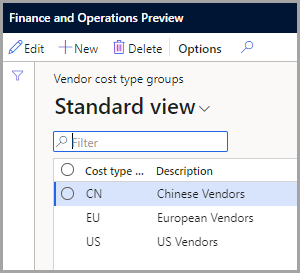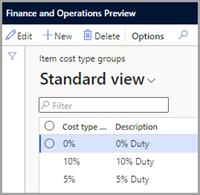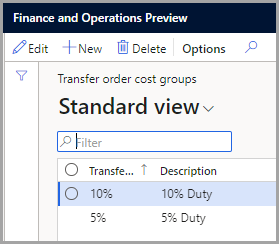Set up costing parameter values
When setting up the Landed cost module, you can define multiple sets of common values and the associated settings for each value. These values will be available subsequently in other areas of the app when you select specific types of costing parameter values. This section describes how to set up these value sets.
Set up cost type codes
Cost type codes define the type of cost that's incurred when products are delivered to the warehouse or with the landed costs of a voyage. While they typically increase the value of goods, you can also use them to accrue sums to the ledger. Adjustments to the ledger happen when a cost is accumulated over time or throughout a series of voyages and then offset in a single transaction.
Note
If the Cost type table is shared among legal entities, the accounts chart must be shared as well. Otherwise, the posting transactions will fail.
Go to Landed cost > Costing setup > Cost type codes. On this page, you can view, edit, create, or delete cost type codes. Each cost type code contains the following fields.
Cost type code - Enter the name for the code.
Description - Enter the code description.
Use shipping rate - Set this toggle to Yes if you use the voyage exchange rate (also known as a management rate) to determine the value of this cost. In this instance, the shipping rate will be used to exchange foreign currency invoices rather than the default or spot exchange rate.
Reporting category - Determines the reporting category for the cost type. You can run reports by the reporting category or the cost type.
Debit type - Determines whether the cost should debit the item, the ledger account, or the vendor.
Debit posting - If the Debit type field is set to Ledger account, select the posting description that you want to use.
Debit account - If the Debit type field is set to Ledger account, select which debit account to use.
Credit type - Determines whether the cost type should credit the item, the ledger account, or the vendor.
Credit posting - If the Credit type field is set to Ledger account, select the posting description that you want to use.
Credit account - If the Credit type field is set to Ledger account, select which credit account to use.
Clearing account - Select which clearing account that you want to use. To help with the reconciliation process, we recommend that you create a separate clearing account for each cost type.
Standard cost type - If you're using standard costing, you need to select the posting description.
Standard cost variance account - If you're using standard costing, you need to select the account where you'll post the variances. On the Item pricing page, this account will use the landed cost breakdown. You can generate this breakdown by running the periodic routine to update prices.
For instance, the standard price of an item is USD \$15.00, the Freight on Board (FOB) price is \$13.00, and the freight cost is \$ 2.00. When the stock invoice is received, the item is received at \$15.00 but with a variance of \$2.00 because the FOB is \$13.00. This variance is recorded to the standard price variance account that is set up in the item posting profile. Because the freight estimate was \$2.00, no variance is added when the stock invoice is posted. However, when the actual freight invoice is received, the freight is \$2.50 for each unit. As a result, a \$0.50 variance is added to the item cost.
Moving average variance account - If you use moving average costing, you need to select the account where you'll post any variance.
For example, the estimated freight is \$2.00. However, when the freight invoice is received, the freight is \$2.50 for each item. Therefore, the \$0.50 variance must be posted to an account.
When the Post adjustments as variance option on the Landed cost parameters page is set to Yes, all variances between estimated and actual cargo costs are posted to the moving average variance account that you specify on this page.
When the Post adjustments as variance option is set to No, the standard functionality will be used. The variance is applied to inventory or to the moving average variance account that you specify on this page, depending on the amount of stock on hand.
Charge accrual account - Select which account that you want to use to accrue cost estimates when you’re posting the purchase invoice. You'll only use this setting when the Use cost type charge accrual account option is set to Yes on the Costing FastTab on the General tab of the Landed cost parameters page.
Charge account - Select which account that you want to use to capture the inbound transportation costs that a supplier has invoiced. This amount is posted as a debit and the offset account is the stock variation account.
You'll only use this posting when the Post to charge account in ledger option is set to Yes on the Accounts payable parameters page.
Variance account - Use this account to offset the charge accruals when you’re posting a purchase invoice. You'll only use this field when the Use cost type charge accrual account option is set to Yes on the Costing FastTab on the General tab of the Landed cost parameters page.
Split cost type codes for multiple voyages
You must have a thorough understanding of the expenses related to product transportation. Although this can be challenging to do when there are numerous voyages involved each with its own charges and cost type codes that are merged into a single invoiced issued by the shipping provider. This feature enables you to split vendor invoice journals based on the cost code type. Now, when you are creating a vendor invoice journal that includes multiple voyages, you can add multiple journal lines for each cost type code. This will allow your organizations to allocate costs on a more granular basis by breaking down costs from each voyage according to the cost type code.
Vendor cost type groups
Vendor cost type groups help to define how auto cost charges are identified and applied to a voyage. Vendors with comparable import costs are grouped together. For example, all vendors from emerging markets pay the same duty percentage for the same type of product that's purchased from an established market.
Go to Landed cost > Costing setup > Vendor cost type groups to create and maintain these groups.
The Vendor cost type groups page lists all existing vendor cost type groups. You can use the buttons on the Action Pane to edit, add, and delete vendor cost type groups. Each vendor cost type group contains the following fields.
| Field | Description |
|---|---|
| Vendor cost type group | Enter a unique name for the group (such as EmgMkt). |
| Description | Enter a description of the group. The description should include information about why the vendors are grouped together, such as the level or type of charge that’s associated with them. |
Item cost type groups
Item cost type groups help to define how auto cost charges are identified and applied to a voyage. Similar items are grouped together. For example, all items with a 5 percent duty rate belong to a specific cost type group.
Go to Landed cost > Costing setup > Item cost type groups to create and maintain these groups. The Item cost type group page shows you all current groups. You can use the buttons on the Action Pane to edit, add, and delete these groups.
Each item cost type group contains the following fields.
| Field | Description |
|---|---|
| Item cost type groups | Enter a unique name for the group (such as Duty 5%). |
| Description | Enter a description of the group. The description should include information about why the items are grouped together, such as the level or type of charge that’s associated with them. |
Note
The item cost type is linked to the item through the Cost type group field on the Purchase FastTab of the item's Released products page.
Transfer order cost type groups
Transfer order cost type groups help to define how auto cost charges are identified. Similar items are grouped together. For example, all items with a 7 percent duty rate might belong to a specific cost type group.
Go to Landed cost > Costing setup > Transfer order cost type groups to create and maintain these groups. The Transfer order cost type group page shows you all current groups. You can use the buttons on the Action Pane to edit, add, and delete these groups.
Each transfer order cost type group contains the following fields.
| Field | Description |
|---|---|
| Transfer order cost type groups | Enter a unique name for the group (such as Duty 7%). |
| Description | Enter a description of the group. The description should include information about why the items are grouped together, such as the level or type of charge that’s associated with them. |
Note
The transfer order cost type is linked to the item through the Transfer order cost group field on the Purchase FastTab of the item's Released products page.
Cost templates
Cost templates help you create default values for settings that people who are receiving a cost estimate might not know. As a result, cost templates can help simplify the process by reducing the number of choices that users must make to obtain an accurate estimate.
Go to Landed cost > Costing setup > Cost templates. The Cost templates page shows you all available templates. You can use the buttons on the Action Pane to edit, add, and delete templates.
Each cost template contains the following fields.
| Field | Description |
|---|---|
| Cost template | Enter a unique name for the template. This name usually describes the factor or cost multiplier. |
| Description | Enter a description for the template. |
| Shipping company | Select the vendor account of the shipping company that you want associated with this template. |
| Mode of delivery | Select which mode of delivery that the cost template will use when calculating the estimated cost of an item. This field helps determine the auto costs that are associated with the goods that are included in the cost estimate. |
| Shipping container type | Select which shipping container type that you want to associate with the cost template. This field helps determine the auto costs that are associated with the goods that are included in the cost estimate. |
| Custom broker | Select the custom broker (vendor) that you want to associate with this template. This field helps determine the auto costs that are associated with the cost template. |
| Factor | Enter a factor that you want applied to the final cost estimate of goods. For example, if you want to add 15 percent to the calculated cost estimate, enter 1.15. |
Volumetric divisions
You can calculate the volumetric weight by using volumetric divisors. Each shipping/freight company develops their own volumetric divisors. Furthermore, a company's divisors generally vary based on the delivery method. For example, the divisors for air and sea are substantially different. In addition, depending on where it ships from, a company can potentially make the rules more complex.
For example, a package that is shipped by air has a volume of 3 cubic meters (m3). The company charges by volumetric weight with a volumetric divisor of 6. The volumetric weight is calculated by multiplying this divisor by the volume. As a result, the volumetric weight in this example is 36 = 18 kilograms (kg).
Go to Landed cost > Costing setup > Volumetric divisors. The Volumetric divisors page shows you all existing volumetric divisors. You can use the buttons on the Action Pane to edit, add, and delete the divisors. Each volumetric divisor contains the following fields.
| Field | Description |
|---|---|
| Shipping company | Select the vendor account of the shipping company that you want associated with this divisor. |
| Cost type code | Select the cost type code that you want associated with this volumetric divisor. Use this field to put cost types into reporting buckets. You can generate reports by reporting categories or by cost type. |
| From port | Select the from port that applies to this divisor. |
| Volumetric divisor | Enter the applicable volumetric divisor value. The value that you enter in this field will be multiplied by the volume of each package to determine the total volumetric weight of that package. |






